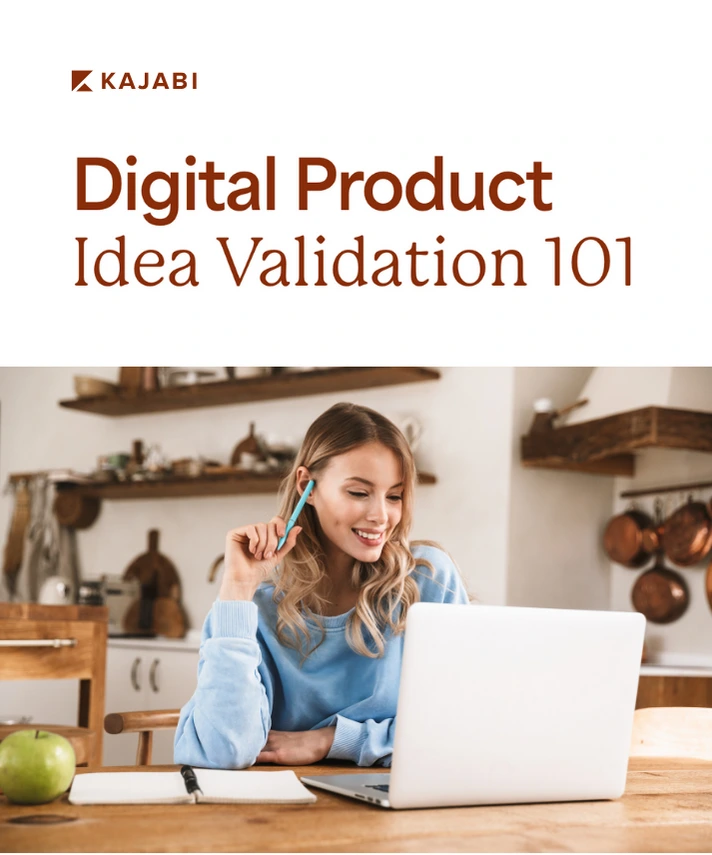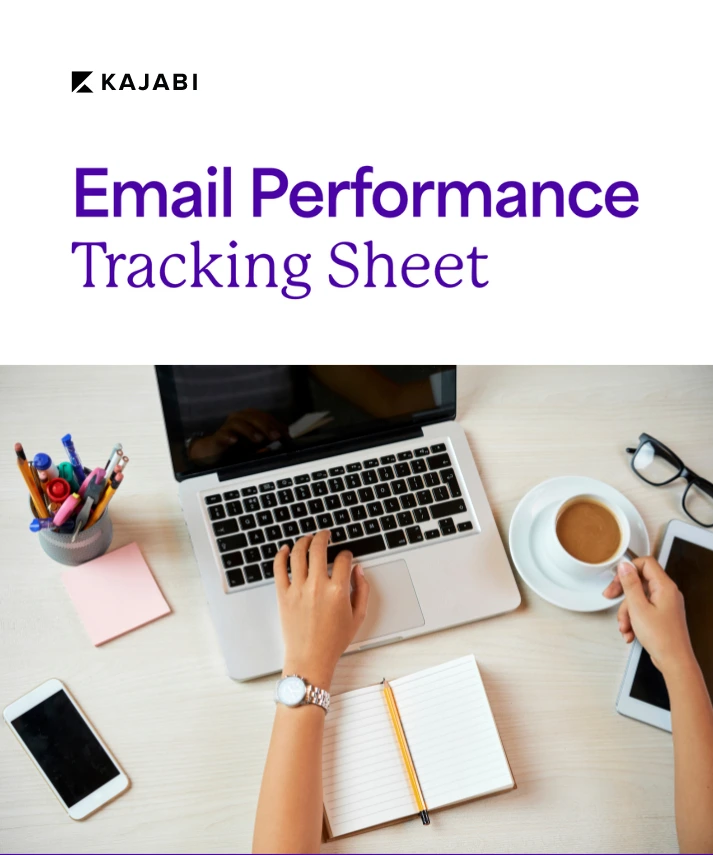
What is customer lifetime value and how to calculate it (Formula)
Get free expert insights and tips to grow your knowledge business sent right to your inbox.
When it comes to marketing metrics, we all know you’ve got plenty to choose from, right? But for those of us don’t exactly have “beautiful minds” and aren’t solving long form equations on chalkboards to pass the time...there’s good news!
Less is actually more in the land of business performance.
In fact, data overload can cripple a Knowledge Commerce business. All that time crunching the wrong numbers, could’ve been time spent on launching new projects and making sales.
But yes, there are a few marketing metrics you should track regularly, and customer lifetime value (CLV) is one of the most important because it can directly impact everything else.
If you’re not familiar with CLV or if you’ve never tracked your customers’ lifetime value, have no fear, Kajabi is here! And class is in session. Once you’ve read this article you’ll know exactly what to do...
We’ll explain the definition and importance of customer lifetime value and provide you with a simple formula as well as a real-world example. That way, you’ll have everything you need to calculate CLV correctly and (more importantly) how to apply what you learn from it.
What Is Customer Lifetime Value?

For many business owners, customer lifetime value is the missing piece in the puzzle. It’s a metric which finally shines a light on why the business is soaring to new heights or slowly sinking day after day.
Customer lifetime value is the total monetary value a customer brings to your business throughout the entire relationship. So instead of focusing on single transactions, you shift your priority to individual customers and their total contributions to your success.
If that sounds like a big deal, it’s because it is.
And keep reading because this one concept can be an overnight game changer if done right.
A single transaction puts money in your pocket, but you don’t want the relationship to end there. Instead, you want your customers to return to your website and buy more of your digital products.
By focusing on customer lifetime value (CLV), you can increase sales overall and build long-term relationships with your customers. That way, you’re not constantly struggling to acquire new customers so your business stays afloat.
It’s easiest to understand CLV when you view it from a brick-and-mortar point of view. Examining how customer behaviors vary depending on the products they buy can help you see the value of calculating CLV.
Let’s say that you own a supermarket. Your customers visit once per week, on average, and every family buys different products.
One customer might purchase 10 apples per week. Each single transaction is only valued at a few dollars. However, when valued over several years, those once-per-week purchases become highly significant.
A customer who spends $7 per week will spend $364 per year. Over a 10-year period, that same customer will spend a total of $3,640.
Let’s say that your supermarket customer spends an average of $200 per week on groceries. The numbers skyrocket: $10,400 per year and $104,000 over a decade.
This is one reason why membership sites have become so popular. They create consistent income for the business, of course, but they also increase the average CLV per customer.
Several variables impact CLV. For instance, if you have one extremely expensive product, your average CLV might be higher than if you sold lots of inexpensive products. On the other hand, if you have lots of products from which to choose, your CLV can increase because your customers might come back to try out more of your digital products.
It’s your job as a business owner to figure out what variables impact your own CLV so you can maximize it across your customer base.
Going back to the brick-and-mortar example, let’s say that you own a furniture store instead of a supermarket. You’re selling goods, such as couches and chairs, that often last your customers years. A grocer, on the other hand, sells products with short shelf lives.
Both stores can improve their CLVs, but they have to understand what brings their customers back and why. Furthermore, they have to figure out how to maximize the value of each transaction.
Why Is Customer Lifetime Value (CLV) Important?

As your business evolves, you’ll have to approach digital marketing in new ways. Your goals might shift as you add new products, develop new strategies, and target new audiences.
However, you always want to focus on maximizing your customer lifetime value. The strategy might change, but the goal won’t.
CLV is important because it communicates the health of your business and the quality of your relationship with your customers. If most people buy one thing from you and never return, you know you need to focus on nurturing your existing customers.
Additionally, low CLV will tell you that you need to focus more on cross-selling, upselling, and downselling. If you encourage your existing customers to spend more per transaction, your CLV will naturally go up.
(By the way, this ^^^ is the easiest way to make more sales. You’ve already spent the money and time acquiring the customer, now simply offer them MORE of what they want.)
Since you can calculate CLV the same every time you do it, the numbers are more accurate. They’ll continue to reflect the actual lifetime value of each customer.
With all that said, let’s look at the five most significant areas of impact that CLV has on your business.
1. Boost Your Overall ROI Per Transaction and Per Customer
When you focus primarily on customer lifetime value, your goal is to boost ROI for every transaction, but also to increase ROI for each customer. Those are two very different things.
Increasing the ROI of a transaction might be as simple as offering a bundled package, an upgrade at a discount, or some other incentive to spend more money. The transaction might increase from $100 to $200.
That’s not enough, though. You want to increase the ROI for each customer. When you spend less and earn more from a customer, the CLV increases.
You might already know your customer acquisition cost. This is how much money you spend on marketing and advertising to convert one customer.
When you reduce your customer acquisition cost, your revenues (and ROI) increase. You’re pocketing more of the money you earn for each transaction.
If you then multiply those savings over multiple transactions with the same customer, your ROI goes through the roof. The savings get compounded each time a customer returns to one of your landing pages and clicks the checkout icon.
Business owners who look at the big picture over a long period of time often experience more success. It’s the difference between being a flash in a pan or business that lasts.
They understand that their survival depends on not only acquiring new customers, but also on convincing existing customers to come back.
On average, business owners spend five times more money acquiring a customer than they do on customer retention. In other words, it’s the difference between spending $20 and spending $100. That’s a huge deal for any business.
2. Increase Your Customer Retention Rates
Speaking of customer retention, you can often gauge a business’s health by inquiring about its customer retention rates. A company that keeps customers coming back for more can sustain itself through the inevitable peaks and troughs in the revenue graph.
Sure, you’ll have times when you don’t earn as much money as you did in previous weeks or months. That’s natural. But you don’t want a lean period to crush your business.
Customer retention rates reveal how many of your customers come back to buy more of your products. A customer who buyers each new online course you debut is worth more than someone who buys a single course and never returns.
Again, we’ve circled back to customer lifetime value.
Creating a membership site and building multiple online courses can help boost those retention rates and increase CLV. After all, you’re not in an industry where you can sell the same product over and over.
Look at online courses versus a product like soap. People buy soap several times a year (hopefully lol) because they run out of it. Your online courses, however, aren’t renewable, so you have to bring more Knowledge Commerce products to the table.
It’s worth the effort, though, because your CLV and customer retention rates will skyrocket. Your business will become healthier as a result, which ensures a better future for your company.
Keep in mind, though, that you don’t want to rush your products through production. Maintain the high value standards you’ve set for yourself. Otherwise, you might drive even loyal customers away.
That’s the delicate balance inherent to CLV. You feel pressured to create as many products as possible, but your customers won’t forgive faulty information or poor video production quality.
This is why you need to focus on CLV from the beginning. You’ll feel encouraged as your CLV grows and your customers become increasingly loyal to your business.
3. Target and Nurture Prospects With More Accuracy
CLV isn’t all about the numbers. While you want to know the math, you also want to know the cause. Is your CLV increasing or decreasing? And why?
Numbers fluctuate all the time, of course, based on many variables. For instance, you might experience more sales during certain times of year because of your target audience’s interest. Economic changes can also affect how people spend their money — especially when it comes to discretionary income.
However, you’re looking specifically for trends that defy external factors.
We’ve already talked about the importance of customer retention. However, it’s also important to look at the cause behind retention.
Consumers who remain loyal to a business and who reliably buy its products typically contribute far more to the company’s bottom line than a whole group of people who shop there just once. It’s sort of like the Pareto Principle, viewed in a different light.
The majority of your revenue will come from a minority of your customers. That might sound backward, but it comes down to customer retention and CLV.
If you’re able to identify that minority group and nurture it over months and years, you can boost your revenue even further. But first you need to know what drives them — or drives them away.
Your research might reveal, for instance, that your customers return to buy more of your products when you communicate with them regularly through email marketing. If you’ve discovered this, you should ramp up your email marketing program to take advantage of it.
Alternatively, maybe your metrics show that a certain online course format proves more popular among repeat customers. That’s your cue to make similar products so they appeal to your loyal buyers.
Simply put, CLV will help you target customers effectively because you’ll know what drew in your most loyal consumers. Plus, it will show you how to nurture them over time so they don’t divert to a competitor.
4. Track Customer Paths to Purchase
We’ve mentioned before here on the Kajabi blog that customers typically make multiple touch points with a brand before they actually purchase a product or service. They might see a paid search ad, read a blog post, follow the company on social media, and click on an email CTA link.
Using Kajabi’s metrics, you can track these paths to purchase to better understand your customers’ route to purchasing. How many touch points do they make, on average? Which tough points result in the most conversions?
First, though, you need a reliable attribution model.
Many businesses use last-touch attribution when tracking customers’ paths to purchase. In other words, they credit the final touch point as the sole contribution to conversion.
You might want to avoid this strategy.
Giving each touch point at least a portion of the credit will give you a more holistic view of your data. It’s typically the cumulative exposure to a brand that causes a conversion.
For instance, you might give 30 percent credit to the first touch, 40 percent credit to the last touch, and equal credit to each touch in between. There are plenty of attribution models — test several to get a feel for which gives you the most accurate understanding of the customer’s path to purchase.
Once you’re armed with this data, you can optimize the touch points that matter most. Maybe it’s paid social and email marketing. Perhaps it’s blogging and remarketing advertisements. Whatever the case, those touch points deserve your time and cash.
This research into CLV will also tell you when you need to spend time or resources on those marketing strategies. For instance, you’ll figure out how often your audience wants to hear from you via email.
All the while, your efforts will contribute to an enhanced CLV because you’ll acquire and retain more customers. Even your already loyal customers might spend more money because of your enhanced marketing efforts.
5. Learn Where to Focus Your Customer Support Efforts
When you run a small business, you don’t have a huge customer support staff to handle questions, complaints, technical issues, and other needs that might crop up during the day. Consequently, you have to figure out where to focus most of your efforts.
Unfortunately, Knowledge Commerce business owners might not view this as a necessary strategy. They respond to as many customer support needs as possible based on the limited time available to them.
There’s a better way, though. And, as you might have guessed, it comes down to customer lifetime value.
CLV tells you which customers will spend the most money over their lifetime. By virtue of their loyalty, they automatically become more valuable to your business — and therefore more deserving of customer support.
It is toward these people that you should exert most of your energy. Focus on keeping them happy so they don’t have any excuse to seek out your competitors.
Remember that people who have no intention of spending money on your products can still take up your time. When you have limited resources, you can’t afford to squander them.
Advantages of CLV for Knowledge Commerce Pros

In Knowledge Commerce, data is one of your most important assets. It can tell you when you’re heading in the right direction and when you’re not.
More importantly, it draws your attention to areas of your marketing plan that you could optimize for future success.
CLV offers several intriguing advantages:
- Learn what outreach efforts intrigue your audience the most.
- Focus on the customers who spend the most money on your products.
- Build a community of like-minded people who all enjoy learning what you teach.
- Create loyalty among people who might recommend you to others.
The more you know about CLV, the more you’ll understand your target audience — specifically, the minority that produce the majority of your income.
How Do You Calculate the Lifetime Value of a Customer?

Now, we get to the math. It probably sounds complicated, but it doesn’t have to be.
Even if you barely got through high school Algebra, you can easily calculate CLV — especially if you have access to a handy calculator.
First, though, you need to do some research. You’ll need to know how much money you spend to acquire customers, how much customers spend each year at your business, and how many years your customers remain active.
Numerous CLV formulas exist, some of which include upwards of 10 variables. You don’t need to get that specific when it comes to calculating your own CLV.
In terms of getting the initial numbers, you can use historical or predictive modeling.
Historical modeling takes numbers from previous years, while predictive modeling uses forecasts to estimate future numbers. Neither is better than the other, but if you have historical numbers available, you might as well use them. Over time, you can update them based on changing analytics.
Some types of businesses are easier to estimate than others. For instance, if you charge a set rate for your membership site, you’ll know exactly how much your customers will spend each year. When they make discrete purchases, the numbers get a little murkier. Over time, you’ll develop better insights into customer behavior.
Let’s look at the most common and the simplest CLV formula, then discuss how we can add more variables to get more accurate predictions.
Formula
To calculate basic CLV, you need to know three pieces of data:
- How much the average customer spends in a year
- The number of years each person remains a customer
- The cost of customer acquisition
That’s pretty simple, right?
To calculate CLV, multiple the first two numbers together, then subtract the third number.
Let’s look at an example.
Let’s say that your customer spends $400 per year and remains a customer for 10 years. You multiple those two numbers together to get $4,000.
If the cost of customer acquisition is $50, you need to subtract $50 from $4,000, which gives you $3,950. That’s your customer lifetime value (CLV).
See? It’s not that scary when you start writing down the numbers.
Of course, you might want to include other variables. Maybe your customers tend to increase their annual spend by $20 every year. In that case, you’ll have to calculate each year separately.
In our example above, the customer would spend $400 the first year, $420 the next year, and $440 the year after that. If we go all the way to 10 years, we get a total expenditure of $4,900, with the customer spending $580 in the final year of the decade.
This brings our customer lifetime value to $4,850 if we keep the customer acquisition cost the same.
But what if your costs related to your customers increase, too? Maybe you’ll want to include expenses related to customer retention.
In this case, you can calculate the cost spent per customer for every year. Add it up, just like you did the yearly expenditure by customers, then multiple the final numbers as in the original formula.
Customer Lifetime Value Example

To see an example of customer lifetime value (CLV) in action, we can look no further than e-tail giant Amazon. The company has always taken a data-centered approach to customer acquisition and retention, which might explain its ability to monopolize e-commerce.
According to Barn Raisers, LLC, Amazon determined in 2013 that Kindle customers spent more than consumers who did not own Kindles. Specifically non-Kindle owners spent $790 per year at Amazon.com, while Kindle owners spent $1,233 — a $433 difference.
This prompted Amazon to redouble their efforts in marketing to Kindle owners. The company developed Amazon Prime, which is a subscription service that allows members to get discounts on certain products, early access to Kindle e-books, free two-day shipping, and other benefits.
You can see from the Amazon website that Amazon caters very specifically to Amazon Prime members. An entire section of the primary navigation menu is devoted to it.
Similarly, if you want to search the site for products, the “Kindle” section remains very prominent. Amazon knows that many book lovers want to purchase new volumes for their Kindles.
That’s an excellent example of how CLV can play a major part in a large business’s marketing efforts. You can take the same approach to win over more customers and increase CLV.
Use Kajabi To Turn Your Knowledge And Content Into Products You Can Sell
Are you tired of running yourself ragged for your business? Have you avoided starting a business at all because you don’t know where to begin?
Kajabi can help. We’ve built a platform specifically for Knowledge Commerce professionals. Our #KajabiHeroes are professionals who turn their knowledge into cash by selling informational products.
You can sell online courses, e-books, coaching sessions, and anything else that strikes your fancy. Plus, we’ve got all the easy to use technology built right in, allowing you to start a membership site, track your analytics, market your business, and support your customers.
All you have to do is sign up for our 14-day free trial. You’ll have everything you need to start your successful business from the moment you’re a member.
We have a supportive community and mobile-friendly templates as well as a host of other features and benefits. Before you know it, you’ll be an entrepreneurial rockstar.
Of course, don’t forget about customer lifetime value while you’re at it.
Conclusion
Customer lifetime value (CLV) matters more than many entrepreneurs think. In fact, it might be the most important metric you can track.
From customer retention to customer support, CLV impacts just about every other number you can calculate. It can also dictate whether your business thrives or fails.
Customer lifetime value refers to the total amount of money a customer will spend on your business after you’ve subtracted related costs. It’s not the value of a single transaction, but of every transaction, that customer conducts with your organization.
Why is CLV important?
- It can help you increase your overall ROI as well as your ROI per transaction.
- You’ll find it easier to retain customers when you optimize your CLV.
- CLV helps you target and nurture valuable customers.
- You can track customers’ paths to purchase with reliable insight.
- It will tell you where to concentrate your customer support efforts.
There are lots of advantages to knowing and optimizing your CLV, too.
The formula is simple enough to remember. Add up all current and future transaction prices, then subtract the amount of money you’ve spent on the customer. That gives you the CLV.
Use that formula to continuously track CLV patterns so you can optimize for success. Best of all, Kajabi can help.
Do you track CLV for your business? Why or why not?
Learn How You Can Use Kajabi for Your Business
Ready to be your own boss? Ready to monetize your knowledge? You need Kajabi - It’s a full-featured platform that allows professionals like you to create their own businesses from home.
Create online courses, establish membership sites, offer coaching programs, host a podcast, and sell other digital products. Plus, you'll get marketing tools like a website, CRM, email marketing, landing page templates, and helpful analytics to help you spread the word about your products and earn more revenue.
Fully explore what Kajabi has to offer and start building your business during a free trial. Start your free 14-day trial of Kajabi today!
Still researching? Check out Kajabi’s free downloadable ebook guides on launching and growing a knowledge commerce online business!




.jpeg)








